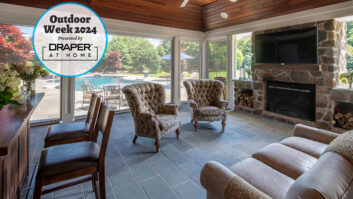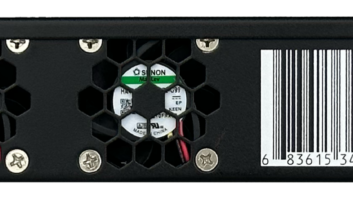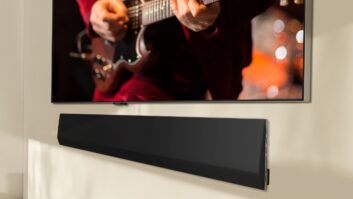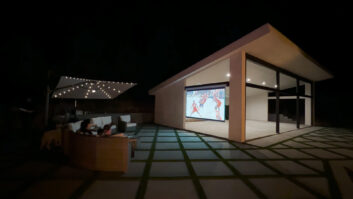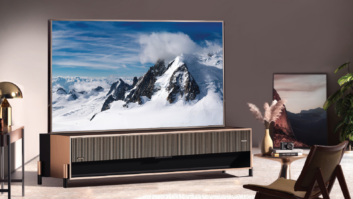Bringing the cinema experience home has often seemed like more of a function of plush theater seating, antique movie posters, surround sound, and of course, video projection technology. But binding all of these implements together is the literal wallflower of the home theater experiencethe video projection screen. At once the center and the perpetual afterthought of enthusiasts ambitions for a playroom that can be enjoyed by young and old alike, these shimmering surfaces have exhibited a steady evolution in their capabilities, thanks to a perpetually changing array of needs stipulated by projection technology and viewing habits.
Today, the nearly ubiquitous presence of intensely bright digital projectors and the immense popularity of multipurpose media rooms are adding still more variables to the screen selection process. Instead of compensating for the inadequacies of projection technology as they once did, screens are now fighting new battles of excessive lumens and uncontrolled ambient light.
Logic may dictate that ultra-bright projectors are the ideal solution for the latter scenario in media rooms, but without a screen that helps to reduce reflections off light-colored walls and ceilings, even an intensely bright video image can still appear washed out. Meanwhile, there are other considerations screen manufacturers have to address for dedicated home theater rooms, where ambient light is not an issue. In these cases, digital projectors improved image quality and the availability of an array of high-resolution video formats have clients and designers expressing a renewed interest in acoustically transparent screens and curved offerings for optimal viewing of images projected by new anamorphic lenses.
In general, two-piece projection is experiencing significant growth, and many end-users are making their first-ever screen purchase. This being the case, the projection environment is not always ideal, as customers are mesmerized by the size of a projected image rather than the lighting and decor considerations that would make that image better. There are customers that have a huge wall and thats the size screen they want, and sometimes its so large that it just doesnt make sense, observed Vutec technical director Spencer Mallinson. Its uncomfortable to view. It would be like watching a tennis match at the very center of the net. The size of the screen should really be determined by the viewing distance to the screen, the ANSI lumen rating and throw distance of the projector, and the rooms lighting characteristics. These are all vital in achieving the proper viewing experience. For example, if the rooms lighting is uncontrolled, then you need to consider a higher gain screen or a brighter projector. Fortunately, projection technology may provide an answer to the ego-driven pursuit of larger screens. Theres always been a battle with customers who want the biggest screen that they can fit in the room, conceded Joaquin Rivera, director of sales for Stewart Filmscreen. Now, at the high-end, he noted, dealers are seeing customers opt for the 2.35:1, or Cinemascope, aspect ratio images produced by new projectors that feature anamorphic lenses. This unifies the height of varying image formats, and maximizes the viewing experience, Rivera explained. Customers get a bigger image that uses the full pixel count and brightness of their projector. So its a huge deal right now, he said.
As Cinemascope becomes more popular at the high end, there still persists the trouble of making media room users feel like theyre getting the most out of their projector. In that case, designers are going to have to explain how even the color of paint used on the walls and ceilings of spaces will affect their investment. I recently took some measurements and discovered that a 1000:1 contrast ratio is reduced to 40:1 when theres a white ceiling in the room, said Tony Grimani, president and lead consultant for Performance Media Industries (PMI). In that case, was it worth buying a $25,000 projector? I dont think so.
To prevent a feeling of buyers remorse, Grimani advises dealers to guide their clients decision on screens carefully. The real rationale behind the choice of screens is not about the projector, it is about the room, he said. If you can control the lights and the color of the room, go for a flat white screen because they look much better. If you cant control the light in the room, or the interior designer wants beige everywhere, then you want to go for a high-contrast gray screen.
Put simply, its easy to forget that there are, of course, new projection screen options constantly being introduced. Perhaps most notable are the new generation of screens calibrated to add some directivity to the abundance of light bouncing around media rooms. With these products, light is beamed back into the room and away from the ceiling and walls, and a darkened substrate actually pulls down the brightness of reflected light, protecting the contrast ratio of the image. Some would say that these screens produce hot spots, but as Grimani said, You choose your battle. In a room with white walls its best to try to get the highest contrast at the expense of the uniformity on the screen. But if you can control the light and the colors in the room, then dont sacrifice the uniformity of the light, he said.
Even with the increased projector brightness using a white/gray tinted screen, its not possible to produce any part of the projected image blacker than the white screen, since the projector does not project black light, explained Henrik Mikkelen, sales manager for DNP Electronics. Thus, the real problem is not the type of projector used, but the screen itself. A traditional white or gray-tinted front projection screen is not able to produce a decent image quality in the multi-use space without the need for blinds or motorized drapes to darken the projection area, thus the room is no longer suitable for multi-use.
The relatively recent availability of screens that redirect ambient light or filter it out altogether is a great selling point for two-piece projection, observed Drapers home theater manager, Bob Hadsell, ISF, CTS. As the prices drop on larger plasmas and LCD displays, its much more competitive to sell a large picture using two-piece, he said. So dealers are looking for more alternatives in ambient light situations.
An additional ambient-light reducing upgrade that dealers should consider in multipurpose rooms is motorized drapes. Thats the one key profit center that most A/V installers are missing, Hadsell said. More often than not in those installations they are controlling other parts of the house, and to not work with motorized shades or drapes to help control ambient light, theyre not offering everything that they can to their customer.
Another option in both rooms with high ambient light and in dedicated home theaters is the curved projection screen, a product that several manufacturers are enhancing for new introductions. Often used in commercial cinemas, a curved screen offers several benefits in residential applications, most notably uniformity and brightness. It helps funnel the light toward the audience not toward the wall, Rivera explained. It also provides a little bit of a wider viewing angle at the back of the room.
Additionally, in applications where an anamorphic lens is in use, if you curve the screen slightly there is less distortion on the edges, noted Kevin Leja, president of St. John Group, U.S. distributors of Screen Research products, which will soon debut a line of curved screens. Curved screens also produced a feeling of being enveloped by the image.
For the home theater enthusiast who wouldnt dare let ambient light seep into the room, there are still more options in screen selection. The vast majority of our dealersespecially those doing the dedicated rooms where theres no ambient lightare going away from the high-contrast screens and back to white screens, Hadsell said. When DLP projectors first came out it was thought that you had to have a high-contrast screen, but the technologys leapfrogged that philosophy to the point where its not necessary anymore.
Also of note in this niche of avid home theater fans is a new devotion to acoustic transparency in their screens. While a debate rages about whether these products, which come in perforated and woven varieties, reduce image quality and even audio quality, there are some who say that the only true cinematic experience is one where at least the center channel audio is localized to the image. Today the vast majority of our designs use an acoustically transparent screen, Grimani said. The benefits by far outweigh the micro-level loss of audio quality. The sum total of the experience is better.
Seconding that motion is Leja, who years ago was converted to Screen Researchs woven acoustically transparent screen fabric along with Grimani. With woven screens, Leja insisted, minimal light loss and maximum acoustic neutrality make for a better experience. Once you realize that you can be a better theater designer by putting the speakers behind the screen, you start seeing all kinds of additional benefits, Leja said. First, interior decorators are happy to see front speakers disappear from view. Second is the boon to margins. I have guys telling me that they can sell a better-quality audio system using our screens, Leja said. In the custom business we always talk about selling video to sell better audio because theres no margin in video. So if you can sell better audio by selling a good screen, youre going to make more profit.
Optimizing acoustically transparent screens is a process with as many variables as the number of screen options available today. In terms of performance, those considering perforated screens should watch out for the moir effect often caused by pixel projectors on these surfaces. Additionally, some screens are more transparent than others when it comes to sound quality, and on the topic of image quality, preventing light loss and reflection from behind the screen is very important, so a black backing is advised. And finally, when placing speakers behind a screen, ideally at least six inches of space should be allowed between screen and speaker to prevent high-frequency attenuation, and acoustic dampening behind the screen is also a good idea.
With so many options in projection screen technology and so many customers created by descending projector prices, manufacturers are fielding all sorts of calls seeking advice from dealers and customers alike. But as awareness increases, business will likely increase as well. Once you experience the larger image size, even if its just a portable or a tripod screen, at some point youre going to move up to the next level, which is a fixed wall screen, observed Matt Teevan, marketing manager for Da-Lite. Thats the entry point, and these customers, once theyre impressed with the size that two-piece projection can accomplish, theyre willing to upgrade as time goes on.
Kirsten Nelson is editor at large for Systems Contractor News.

